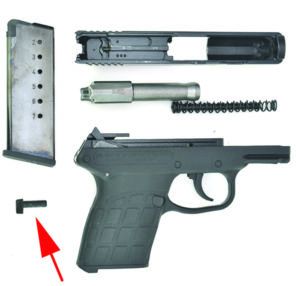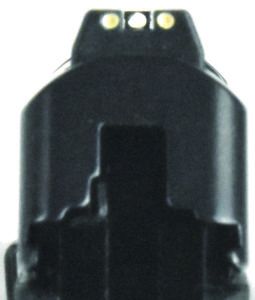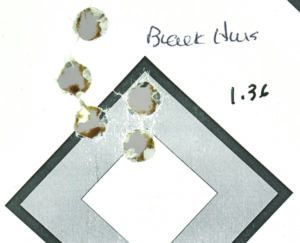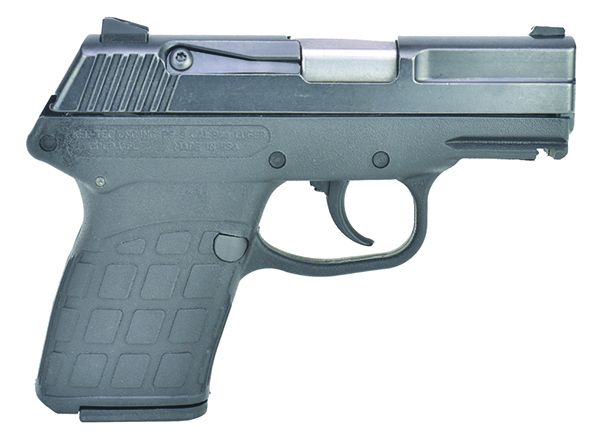GUN TESTS GRADE: B+
$358
We at Gun Tests have examined any number of KelTec designs, with the most recent being the company’s PMR30, a high-capacity 22 Magnum in the October 2020 edition. On the whole, we have found KelTecs to be inexpensive, functional firearms whose designs are usually simple. The PF9 continues that trend.
| Action Type | Semi-auto, double action only, hammer fired |
| Overall Length | 5.9 in. |
| Overall Height | 4.4 in. |
| Maximum Width | 0.98 in. |
| Weight Unloaded | 12.7 oz. |
| Weight Loaded | 18.6 oz. with 8 rounds of 124-grain Speer Gold Dots |
| Slide Material | 4140 steel |
| Slide Retraction Effort | 16.5 lbs. |
| Receiver Material | Polymer |
| Finish | Matte black |
| Front Strap Height | 1.7 in. |
| Back Strap Height | 2.5 in. |
| Barrel Length | 3.1 in. |
| Grip Thickness (Maximum) | 0.88 in. |
| Grip Circumference | 4.9 in. |
| Magazine | One 7-round |
| Rear Sight | Drift adjustable, 2-dot steel |
| Front Sight | 1-dot steel, fixed |
| Sight Radius | 4.2 in. |
| Trigger Pull Weight | 4.8 lbs. |
| Trigger Span | 2.9 in. |
| Safety | Hammer block |
| Warranty | Lifetime for original owner |
| Telephone | (321) 631-0068 |
| Website | KelTecWeapons.com |
| Made In | U.S.A. |
Introduced in 2006, the PF9 has been an outstanding success for KelTec. It contains only 40 parts in its diagram, including those for the magazine, making it simple to use and simple to maintain. The slide is milled from a single block of 4140 steel and is finished in a not-quite-matte black. The barrel is also milled from 4140 steel and, as with all the pistols in this test, is fully ramped and should do a good job supporting the case in the chamber.

The extractor is a simple bar and hook that fits in a recess on the exterior of the slide. It is attached at the rear with a Torx screw. The front sight is a short plastic post fixed permanently to the slide. The rear sight is also plastic and is held in place via a hex-head screw. Some lateral movement of the rear sight is possible upon the loosening of the screw.
Takedown is accomplished via removal of a single pin. Normal stuff here — remove the magazine, check the chamber more than once to make sure it is empty and lock the slide to the rear. The takedown pin is located immediately in front of the slide stop but does not project out from the side of the frame. It is slotted, and the rim of a shell casing can be inserted into that slot so the shooter can pull the case out from the side of the frame, bringing the takedown pin with it. Slide the top end forward and off the frame. Lift out the recoil-spring guide rod with its nested recoil springs and then the barrel to complete disassembly. Reassemble in reverse order, but watch the takedown pin when doing so. You will see a lateral spring that extends across the hole in which the takedown pin must be inserted. There is a small notch on the underside of the face of the takedown pin, and that pin must be inserted far enough that the spring slides up into that notch. Also note that the instructions state that when the top end is reassembled and ready to place on the frame, the barrel hood must be depressed for

the slide to be pushed to the rear correctly. Otherwise, the takedown pin does not capture the barrel correctly to the slide. As always, it’s a good idea to read the manual.
The frame is a simple polymer shell into which a chassis has been molded. The metal rails of the chassis are more than mere tabs and extend beyond 3 inches, giving a great deal of strength and support to the slide. Large raised rectangular bumps provide texture for grip control, though it is a little less control than we prefer. Fire control on the PF9 is double action only, utilizing a very simple linkage directly to the hammer. It really does feel like the trigger on a small revolver. The required pull is fairly long, but this KelTec trigger needs less than 5 pounds of pressure to break a shot, and the trigger stroke is smooth. The hammer is visible through a port in the rear of the slide and could be touched, but it does not protrude far enough to be manipulated.

HoneyBadger ammo. This is the best group with that load.
Feeding and function were perfect. The KelTec shot the largest groups, with an average of 2.10 inches, but a good part of that seemed to be that this pistol just did not like the SIG V-Crown ammo. Average group size on those was larger than 2.5 inches. Average shooting-drill time was about 0.5 seconds slower than the other pistols being tested. We thought that was a function of the longer trigger stroke. We also don’t know that half-a-second spread over five shots from a small defensive handgun is statistically significant.
Our Team Said: This is an inexpensive pistol that functioned flawlessly. It reminded us of a good 38 Special snubbie with a seven-round magazine — only we wish the revolvers had a trigger this smooth.
9MM Luger Range Data
All our range shooting was done from a well-sandbagged Caldwell Pistol Rest. We shot each pistol for accuracy using five-shot groups at 12 yards. Muzzle velocity was determined using a LabRadar chronograph ($559 at BuyMyLabradar.com). Test location for this comparison was American Shooting Centers (AMShootCenters.com) in Houston.| Black Hills HoneyBadger 100-grain Scalloped Copper | Taurus G3C | S&W Shield EZ9 | Ruger American | KelTec PF9 |
| Average Velocity | 1106 fps | 1159 fps | 1190 fps | 1136 fps |
| Muzzle Energy | 272 ft.-lbs. | 298 ft.-lbs. | 315 ft.-lbs. | 286 ft.-lbs. |
| Average Group | 1.83 in. | 1.43 in. | 1.15 in. | 1.82 in. |
| Best Group | 1.40 in. | 1.34 in. | 1.06 in. | 1.36 in. |
| SIG Sauer V-Crown 115-grain JHP | Taurus G3C | S&W Shield EZ9 | Ruger American | KelTec PF9 |
| Average Velocity | 1084 fps | 1115 fps | 1141 fps | 1073 fps |
| Muzzle Energy | 300 ft.-lbs. | 318 ft.-lbs. | 332 ft.-lbs. | 294 ft.-lbs. |
| Average Group | 2.03 in. | 1.28 in. | 1.49 in. | 2.55 in. |
| Best Group | 1.50 in. | 1.16 in. | 1.23 in. | 1.76 in. |
| Speer Gold Dot 124-grain JHP | Taurus G3C | S&W Shield EZ9 | Ruger American | KelTec PF9 |
| Average Velocity | 1131 fps | 1182 fps | 1217 fps | 1128 fps |
| Muzzle Energy | 352 ft.-lbs. | 385 ft.-lbs. | 408 ft.-lbs. | 351 ft.-lbs. |
| Average Group | 1.68 in. | 2.08 in. | 0.67 in. | 1.93 in. |
| Best Group | 1.19 in. | 1.64 in. | 0.43 in. | 1.38 in. |
Drill Data
Drill 1 Process: Fire five shots from low ready, USPSA target, 7 yards. Numbers are averages for three repetitions.Drill 2 Process: From low ready, fire five shots into a 5-inch circle at 5 yards. Numbers are averages for three repetitions.
DRILL #1 Data | |||
| Pistol | Time to First Shot (seconds) | Split Average (seconds) | Total Time (seconds) |
| KelTec PF9 | 0.897 | 0.331 | 2.22 |
| Taurus G3C | 0.863 | 0.213 | 1.71 |
| S&W Shield EZ9 | 0.847 | 0.206 | 1.67 |
| Ruger American | 0.813 | 0.208 | 1.64 |
DRILL #2 Data (5x5x5) | |||
| Pistol | Time to First Shot (seconds) | Split Average (seconds) | Total Time (seconds) |
| KelTec PF9 | 0.94 | 0.374 | 2.44 |
| Taurus G3C | 0.963 | 0.275 | 2.06 |
| S&W Shield EZ9 | 1.04 | 0.249 | 2.04 |
| Ruger American | 0.897 | 0.23 | 1.82 |



























Good review. Compare weight and size should be better covered as it is there that the pistol shinesc… beating out th egg competition by doing yeoman’s work. Needs a rail for light/lazer. How does finger pointing work by using index ? Needs work but both article and pistol are outstanding! The⚓
This has been my carry pistol for twelve years. Perfect for concealment. A little snappy, but extremely dependable.